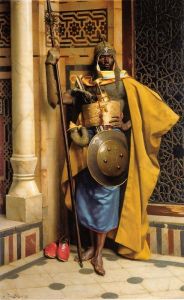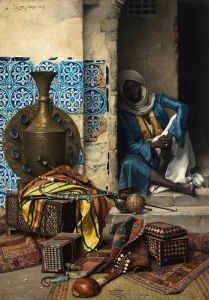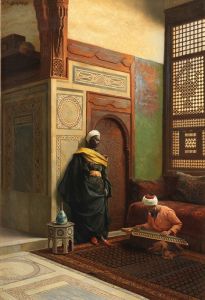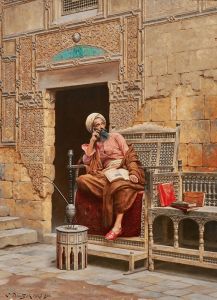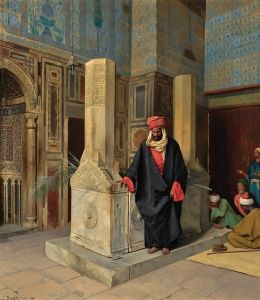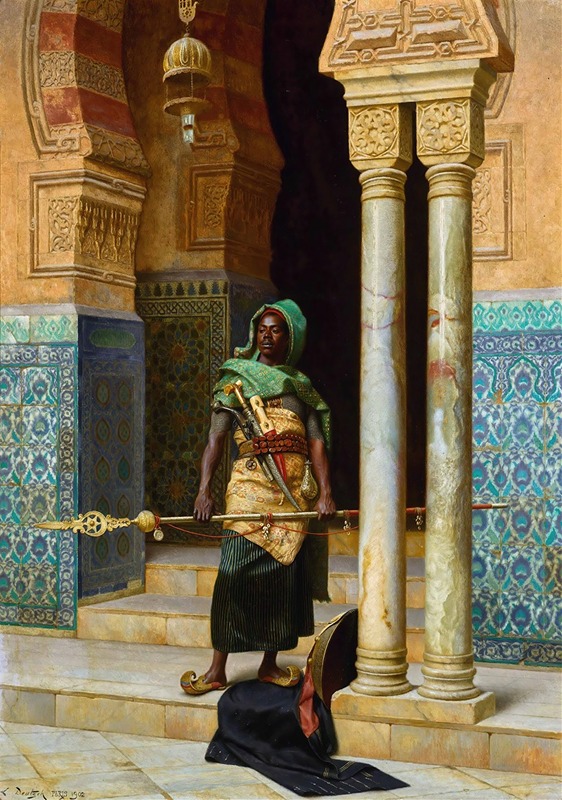
The Nubian Guard
A hand-painted replica of Ludwig Deutsch’s masterpiece The Nubian Guard, meticulously crafted by professional artists to capture the true essence of the original. Each piece is created with museum-quality canvas and rare mineral pigments, carefully painted by experienced artists with delicate brushstrokes and rich, layered colors to perfectly recreate the texture of the original artwork. Unlike machine-printed reproductions, this hand-painted version brings the painting to life, infused with the artist’s emotions and skill in every stroke. Whether for personal collection or home decoration, it instantly elevates the artistic atmosphere of any space.
"The Nubian Guard" is a painting by the Austrian artist Ludwig Deutsch, created in the late 19th century. Deutsch was known for his Orientalist works, a genre that depicted the Middle East, North Africa, and Asia through a Western lens, often romanticizing and exoticizing these cultures. Born in Vienna in 1855, Deutsch studied at the Academy of Fine Arts in Vienna before moving to Paris, where he became part of a community of artists fascinated by the Orient.
"The Nubian Guard" is a striking example of Deutsch's meticulous attention to detail and his fascination with the cultures of the Middle East and North Africa. The painting typically features a solitary figure, a Nubian guard, depicted with a high degree of realism. The guard is often shown in traditional attire, which may include a turban and richly embroidered garments, holding a weapon such as a spear or sword. The background usually consists of intricate architectural elements, possibly inspired by Islamic architecture, such as ornate doorways or tiled walls.
Deutsch's work is characterized by its vibrant colors and precise rendering of textures, from the fabrics of the guard's clothing to the stonework of the surrounding architecture. This attention to detail reflects Deutsch's commitment to capturing the essence of his subjects, albeit through a Western perspective that was common among Orientalist artists of his time.
The painting is part of a broader trend in 19th-century European art where artists sought to depict the "exotic" and "mysterious" East. This movement was fueled by increased travel and exploration, as well as colonial interests in the region. While these works were popular among European audiences, they often perpetuated stereotypes and failed to accurately represent the cultures they portrayed.
Deutsch's paintings, including "The Nubian Guard," are appreciated for their technical skill and beauty, but they also serve as historical documents that reflect the attitudes and perceptions of their time. Today, Orientalism is critically examined for its role in shaping Western views of the East and its impact on cultural understanding.
"The Nubian Guard" and other works by Deutsch are held in various private collections and museums, where they continue to be studied and appreciated for their artistic merit and historical context. As with many Orientalist works, contemporary audiences are encouraged to engage with these paintings with an awareness of their cultural and historical implications.
In summary, "The Nubian Guard" by Ludwig Deutsch is a notable example of Orientalist art, showcasing the artist's skill in rendering detail and his interest in the cultures of the Middle East and North Africa. While admired for its aesthetic qualities, the painting also invites reflection on the broader themes of representation and cultural perception in art.







